Van Vechten Carl
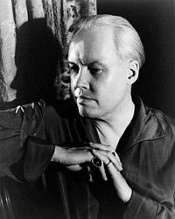
Carl Van Vechten (June 17, 1880 – December 21, 1964) was an American writer and photographer who was a patron of the Harlem Renaissance and the literary executor of Gertrude Stein.[1] Born in Cedar Rapids, Iowa, he graduated from Washington High School in 1898, and later the University of Chicago[2] in 1903. In 1906, he moved to New York City. He was hired as the assistant music critic at the New York Times. His interest in opera had him take a leave of absence from the paper in 1907, to travel to Europe to explore opera.[3] While in England he married his long time friend from Cedar Rapids, Anna Snyder. He returned to his job at the New York Times in 1909 and then became the first American critic of modern dance. At that time, Isadora Duncan, Anna Pavlova, and Loie Fuller were performing in New York City. The marriage to Anna Snyder ended in divorce in 1912 and he wed actress Fania Marinoff in 1914. Several books of Van Vechten's essays on various subjects such as music and literature were published between 1915 and 1920. Between 1922 and 1930 Knopf published seven novels by Van Vechten, starting with Peter Whiffle: His Life and Works and ending with Parties.[4] Van Vechten was interested in black writers and artists, and knew and promoted many of the major figures of the Harlem Renaissance, including Langston Hughes, Richard Wright, and Wallace Thurman. Van Vechten's controversial novel Nigger Heaven[5] was published in 1926. An essay of his entitled "Negro Blues Singers" was published in Vanity Fair in 1926. In the 1930s, Van Vechten began taking portrait photographs. Among the many individuals he photographed were Judith Anderson, James Baldwin, Tallulah Bankhead, Jane Bowles, Marlon Brando, Paul Cadmus, Erskine Caldwell, Truman Capote, Marc Chagall, Salvador Dali, Ruby Dee, Ella Fitzgerald, F. Scott Fitzgerald, Lynn Fontanne, John Hersey, Billie Holiday, Horst P. Horst, Mahalia Jackson, Frida Kahlo, Sidney Lumet, Alfred Lunt, Norman Mailer, Alicia Markova, W. Somerset Maugham, Henry Miller, Georgia O'Keeffe, Sir Laurence Olivier, Diego Rivera, Cesar Romero, George Schuyler, Beverly Sills, Gertrude Stein, James Stewart, Alfred Stieglitz, Bessie Smith, Gore Vidal, Evelyn Waugh, Orson Welles, and Anna May Wong.[6][7] Van Vechten initially met Gertrude Stein in Paris in 1913.[8] They continued corresponding for the remainder of Stein's life, and at her death she appointed Van Vechten her literary executor; he helped to bring into print her unpublished writings. After the 1930s, Van Vechten published little writing, though he continued to write letters to many correspondents. Although Van Vechten was married to Fania Marinoff until the end of his life, he was either a homosexual or a bisexual. Some of his papers were kept under seal for 25 years after his death, and when they were examined after that time, they were found to include scrapbooks of photographs and clippings related to homosexuality.[9] He died at the age of 84 in New York City. Van Vechten was the subject of a 1968 biography by Bruce Kellner, Carl Van Vechten and the Irreverent Decades. Most of Van Vechten's papers are held by the Beinecke Library at Yale University. The Beinecke Library also holds a collection titled "Living Portraits: Carl Van Vechten's Color Photographs Of African Americans, 1939-196", a collection of 1,884 color Kodachrome slides.[10] The Library of Congress acquired its collection of approximately 1,400 photographs in 1966 from Saul Mauriber. There is also a collection of his photos in the Prentiss Taylor collection in the Archive of American Art, a division of the Smithsonian Institution.
do you like this author?
What readers are saying
What do you think? Write your own comment on this book!
write a commentWhat readers are saying
What do you think? Write your own comment on this author!
write a commentBook list

the music of spain
Series:
Unknown
Year:
Unknown
Raiting:
3.5/5
Purchase of this book includes free trial access to www.million-books.com where you can read more than a million books for free. This is an OCR edition with typos. Excerpt from book: Mary Garden (Histoire sommaire de Carmen) ALICE, it will be recalled, adventured into Wonderland bearing a morsel of mushroom in each hand; now she munched one piece, which made her grow tall, now the other, which diminished her height. In this manner she adjusted her size to that of the various doorways and gates of the place as well as to that of the creatures she encountered. In somewhat the same fashion George Borrow, sent by the British Bible Society to distribute the Holy Word in the papal- ized peninsula, advanced into Spain. In one hand he held a Castilian version of the New Testament; in the other his very considerable curiosity. Doubtless he made many valiant attempts to hawk Bibles, but it is quite as certain that he never restrained his natural aptitude for the companionship of thieves, gitanos, contrabandists, and bandits. More than once his zeal in behalf of the Scriptures landed him in jail, but I can scarcely accept this as proof of his devotion to a holy cause when I remember that he had been attempting in vain to persuade certain Madrid officials to permit him to voluntarily incarcerate himself so that he might have such further opportunities for the pursuit of his studies of the " crabbed gitano " as intercourse with the prisoners might offer. As a matter of fact when he was arrested the English Ambassador secured his pardon before the day was done, but this Borrow refused to consider. He was in jail and he proposed to remain there, and remain he did, a matter of several weeks, during which period he had lengthy talks with all the prisoners, adding substantially to his foreign vocabularies. . . . His sympathy, indeed, was with the gitanos; he ate and drank and slept with them, sometimes in stables, sometimes in dirty lofts. If he himself did not connive at...
Show more
add to favoritesadd In favorites
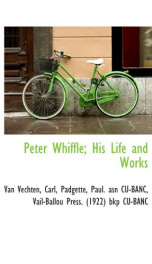
peter whiffle his life and works
Series:
Unknown
Year:
Unknown
Raiting:
2/5
1927. Whiffle was not an author. He had never published or written a book. This work came into existence due to Whiffle leaving a provision in his Will that Carl Van Vechten serve as his literary executor. The author was a friend to Whiffle and it was through the author that Whiffle found the proper outlet for his artistic explosions. This book is written on Whiffle's life from the standpoint and personal experience of Van Vechten. Illustrated. --This text refers to an alternate Paperback edition.
Show more
add to favoritesadd In favorites
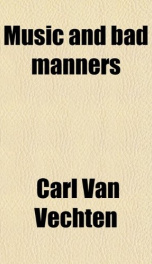
music and bad manners
Series:
Unknown
Year:
Unknown
Raiting:
4.5/5
Purchase of this book includes free trial access to www.million-books.com where you can read more than a million books for free. This is an OCR edition with typos. Excerpt from book: IT has seemed to me at times that Oscar Ham- merstein was gifted with almost prophetic vision. He it was who imagined the glory of Times (erstwhile Longacre) Square. Theatre after theatre he fashioned in what was then a barren district and presently the crowds and the hotels came. He foresaw that French opera, given in the French manner, would be successful again in New York, and he upset the calculations of all the wiseacres by making money even with Pelleas et Melisande, that esoteric collaboration of Belgian and French art, which in the latter part of the season of 19078 attained a record of seven performances at the Manhattan Opera House, all to audiences as vast and as devoted as those which attend the sacred festivals of Parsifal at Bayreuth. And he had announced for presentation during the season of 1908-9 (and again the following season) a Spanish opera called Dolores. If he had carried out his intention (why it was abandoned I have never learned; the scenery and costumes were ready) he would have had another honour thrust upon him, that of having been beforehand in the production of modern Spanish opera in New York, an honour which, in the circumstances, must go to Mr. Gatti-Casazza. (Strictly speaking, Goyescas was not the first Spanish opera to be given in New York, although it was the first to be produced at the Metropolitan Opera House. 11 Guarany, by Antonio Carlos Gomez, a Portuguese born in Brazil, was performed by the "Milan Grand Opera Company" during a three weeks' season at the Star Theatre in the fall of 1884. An air from this opera is still in the repertoire of many sopranos. To go still farther back, two of Manuel Garcia's operas, sung of course in Italian, I'Amante Astuto and La Figlia dell'Aria, were performed at the Park Theatre in 1825 with Maria Garc...
Show more
add to favoritesadd In favorites
Book list

the music of spain
Series:
Unknown
Year:
Unknown
Raiting:
3.5/5
Purchase of this book includes free trial access to www.million-books.com where you can read more than a million books for free. This is an OCR edition with typos. Excerpt from book: Mary Garden (Histoire sommaire de Carmen) ALICE, it will be recalled, adventured into Wonderland bearing a morsel of mushroom in each hand; now she munched one piece, which made her grow tall, now the other, which diminished her height. In this manner she adjusted her size to that of the various doorways and gates of the place as well as to that of the creatures she encountered. In somewhat the same fashion George Borrow, sent by the British Bible Society to distribute the Holy Word in the papal- ized peninsula, advanced into Spain. In one hand he held a Castilian version of the New Testament; in the other his very considerable curiosity. Doubtless he made many valiant attempts to hawk Bibles, but it is quite as certain that he never restrained his natural aptitude for the companionship of thieves, gitanos, contrabandists, and bandits. More than once his zeal in behalf of the Scriptures landed him in jail, but I can scarcely accept this as proof of his devotion to a holy cause when I remember that he had been attempting in vain to persuade certain Madrid officials to permit him to voluntarily incarcerate himself so that he might have such further opportunities for the pursuit of his studies of the " crabbed gitano " as intercourse with the prisoners might offer. As a matter of fact when he was arrested the English Ambassador secured his pardon before the day was done, but this Borrow refused to consider. He was in jail and he proposed to remain there, and remain he did, a matter of several weeks, during which period he had lengthy talks with all the prisoners, adding substantially to his foreign vocabularies. . . . His sympathy, indeed, was with the gitanos; he ate and drank and slept with them, sometimes in stables, sometimes in dirty lofts. If he himself did not connive at...
Show more
add to favoritesadd In favorites

peter whiffle his life and works
Series:
Unknown
Year:
Unknown
Raiting:
2/5
1927. Whiffle was not an author. He had never published or written a book. This work came into existence due to Whiffle leaving a provision in his Will that Carl Van Vechten serve as his literary executor. The author was a friend to Whiffle and it was through the author that Whiffle found the proper outlet for his artistic explosions. This book is written on Whiffle's life from the standpoint and personal experience of Van Vechten. Illustrated. --This text refers to an alternate Paperback edition.
Show more
add to favoritesadd In favorites

music and bad manners
Series:
Unknown
Year:
Unknown
Raiting:
4.5/5
Purchase of this book includes free trial access to www.million-books.com where you can read more than a million books for free. This is an OCR edition with typos. Excerpt from book: IT has seemed to me at times that Oscar Ham- merstein was gifted with almost prophetic vision. He it was who imagined the glory of Times (erstwhile Longacre) Square. Theatre after theatre he fashioned in what was then a barren district and presently the crowds and the hotels came. He foresaw that French opera, given in the French manner, would be successful again in New York, and he upset the calculations of all the wiseacres by making money even with Pelleas et Melisande, that esoteric collaboration of Belgian and French art, which in the latter part of the season of 19078 attained a record of seven performances at the Manhattan Opera House, all to audiences as vast and as devoted as those which attend the sacred festivals of Parsifal at Bayreuth. And he had announced for presentation during the season of 1908-9 (and again the following season) a Spanish opera called Dolores. If he had carried out his intention (why it was abandoned I have never learned; the scenery and costumes were ready) he would have had another honour thrust upon him, that of having been beforehand in the production of modern Spanish opera in New York, an honour which, in the circumstances, must go to Mr. Gatti-Casazza. (Strictly speaking, Goyescas was not the first Spanish opera to be given in New York, although it was the first to be produced at the Metropolitan Opera House. 11 Guarany, by Antonio Carlos Gomez, a Portuguese born in Brazil, was performed by the "Milan Grand Opera Company" during a three weeks' season at the Star Theatre in the fall of 1884. An air from this opera is still in the repertoire of many sopranos. To go still farther back, two of Manuel Garcia's operas, sung of course in Italian, I'Amante Astuto and La Figlia dell'Aria, were performed at the Park Theatre in 1825 with Maria Garc...
Show more
add to favoritesadd In favorites
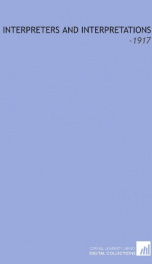
interpreters and interpretations
Series:
Unknown
Year:
Unknown
Raiting:
3/5
Originally published in 1917. This volume from the Cornell University Library's print collections was scanned on an APT BookScan and converted to JPG 2000 format by Kirtas Technologies. All titles scanned cover to cover and pages may include marks notations and other marginalia present in the original volume.
Show more
add to favoritesadd In favorites
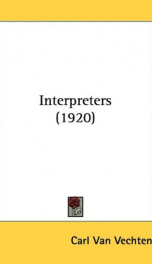
interpreters
Series:
Unknown
Year:
Unknown
Raiting:
3.5/5
Originally published in 1917. This volume from the Cornell University Library's print collections was scanned on an APT BookScan and converted to JPG 2000 format by Kirtas Technologies. All titles scanned cover to cover and pages may include marks notations and other marginalia present in the original volume.
Show more
add to favoritesadd In favorites

in the garret
Series:
Unknown
Year:
Unknown
Raiting:
4/5
Originally published in 1920. This volume from the Cornell University Library's print collections was scanned on an APT BookScan and converted to JPG 2000 format by Kirtas Technologies. All titles scanned cover to cover and pages may include marks notations and other marginalia present in the original volume.
Show more
add to favoritesadd In favorites

The Merry-Go-Round
Series:
Unknown
Year:
Unknown
Raiting:
5/5
Originally published in 1918. This volume from the Cornell University Library's print collections was scanned on an APT BookScan and converted to JPG 2000 format by Kirtas Technologies. All titles scanned cover to cover and pages may include marks notations and other marginalia present in the original volume.
Show more
add to favoritesadd In favorites
What readers are saying
What do you think? Write your own comment on this author!
write a commentif you like Van Vechten Carl try:
readers also enjoyed
What readers are saying
What do you think? Write your own comment on this author!
write a commentGenre
if you like Van Vechten Carl try:
readers also enjoyed
Do you want to read a book that interests you? It’s EASY!
Create an account and send a request for reading to other users on the Webpage of the book!

